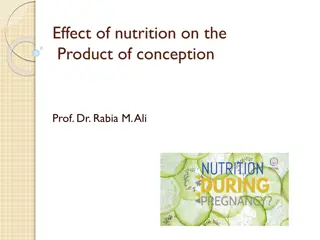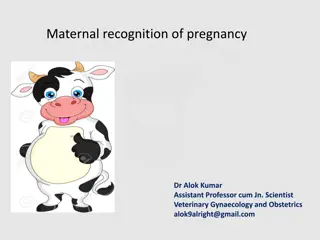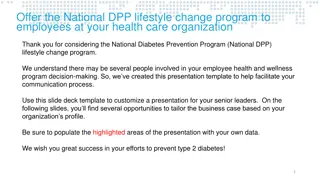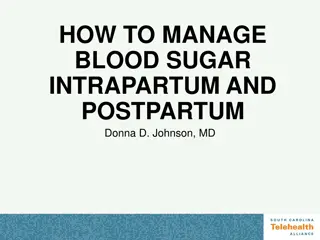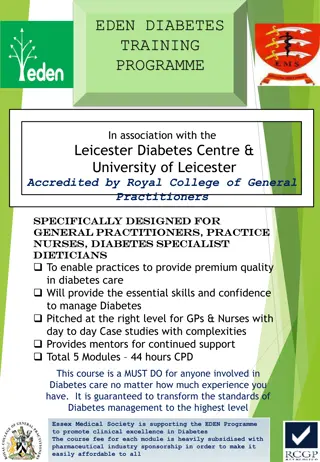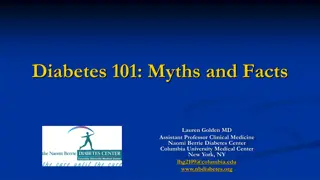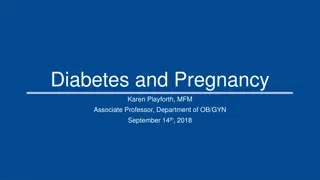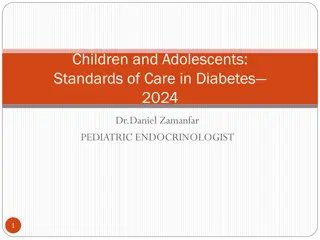Serious Health Problems of Diabetes in Pregnancy
Diabetes mellitus in pregnancy poses significant risks, including poor outcomes, pregnancy complications, and adverse effects on both maternal and fetal health. Complications such as preterm labor, hypertensive disorders, diabetic retinopathy, and stillbirth are common. Proper management and monitoring are essential to mitigate risks and improve outcomes.
Download Presentation

Please find below an Image/Link to download the presentation.
The content on the website is provided AS IS for your information and personal use only. It may not be sold, licensed, or shared on other websites without obtaining consent from the author.If you encounter any issues during the download, it is possible that the publisher has removed the file from their server.
You are allowed to download the files provided on this website for personal or commercial use, subject to the condition that they are used lawfully. All files are the property of their respective owners.
The content on the website is provided AS IS for your information and personal use only. It may not be sold, licensed, or shared on other websites without obtaining consent from the author.
E N D
Presentation Transcript
Vajiheh Marsoosi M.D. Associate Professor of TUMS Perinatology Department, Shariati Hospital
Diabetes And Pregnancy Diabetes mellitus is associated with a high frequency of poor outcomes, clearly representing a serious health problem at the national level. Despite improvement in pregnancy outcomes, women with both GDM and pre-GDM are at greater risk for a number of pregnancy-related complications.
Preterm Labor Infectious morbidities Hydramnios Hypertensive disorders Worsening of diabetic retinopathy
Pregnancy is not associated with either the development or progression of preexisting nephropathy. However, diabetic nephropathy is most likely to affect pregnancy outcomes. There are increased risk of PIH, or worsening of pre- existing hypertension, IUGR, Preterm birth due to fetal distress, and 10 fold increase in the incidence of stillbirth.
Pregnancy is an independent risk factor. Hypertension, poor control early in pregnancy, and rapid normalization all appear to accelerate retinal deterioration. Women with advanced form of retinopathy and longer duration of diabetes are at highest risk for progression. All women with type 1 diabetes for 5 years or more or type 2 diabetes at diagnosis require a through dilated ophthalmologic evaluation.
Stillbirth Congenital malformation Altered fetal growth Metabolic abnormalities Cardiomyopathy RDS Childhood obesity Neuropsychological defects Diabetes
Most often after the 36th week of gestation in patients with vascular disease, poor glycemic control, hydramnios, fetal macrosomia, or preeclampsia. Women with vascular disease may develop fetal growth restriction and IUFD as early as the second trimester.
Two major causes of stillbirth are unexplained fetal death and congenital malformations. The causes of unexplained stillbirth are not well understood but chronic intrauterine hypoxia? Extramedullary hematopoieses is frequently observed in stillborn IDMs. Studies of fetal umbilical cord blood showed relative fetal erythemia and lactic acidemia. Maternal diabetes may also produce alterations in red blood cell oxygen release and placental blood flow.
Poor maternal metabolic control reduced uterine blood flow. Ketoacidosis dehydration, hypovolemia hypotension and reduced uterine blood flow. Preeclampsia narrowing and vasospasm of spiral arteries and reduced uterine blood flow.
Two- to six fold increase in major malformations. CNS anomalies 10 fold Cardiac anomalies 5 fold Sacral agenesis 200 to 400 times more. Congenital malformations account for 30 to 50 percent of perinatal death. Neonatal death now exceeds stillbirth in DM and fetal congenital malformations account for this changing pattern.
Multifactorial: Maternal hyperglycemia Hyperketonemia Hypoglycemia Somatomedin inhibitor excess Free oxygen radicals excess Long standing diabetes with vascular disease Genetic susceptibility to the teratogens
50% in GDM, 40% in type 1 and type 2 diabetes. Birth trauma, increased risk of shoulder dystocia. Impaired metabolic control after birth. Increased risk of obesity later in childhood and adult.
A blood glucose less than 35 to 40 mg/dL during the first 12 hours of life. 50% in macrosomic newborns. The degree of hypoglycemia may be influenced by two factors: Maternal glucose control during the later half of pregnancy Control of maternal glycemia during labor and delivery.
Both hyperglycemia and hyperinsulinemia are involved in delay pulmonary maturation. Insulin blocks cortisol action at the level of fibroblast by reducing the production of fibroblast-pneumocyte factor. Fibroblast-pneumocyte factor acts on type cells to stimulate phospholipid synthesis. Several studies agree that in well controlled diabetic women at term the risk of RDS is no higher than that observed in the general population.
Neonatal hypocalcemiaa, with serum level below 7mg/dL, occurs at increased rate in IDM. With modern management the frequency of hypocalcaemia is less than 5%. Hypocalcaemia is due to failure to increase PTH synthesis following birth. Mg deficiency may inhibits fetal parathyroid hormone secretion. Serum Mg is decreased in diabetic pregnant women as well as their infants.
The pathogenesis remain uncertain. HbA1C values in late pregnancy are significantly elevated in mothers of hyperbilirubinemic infants.




